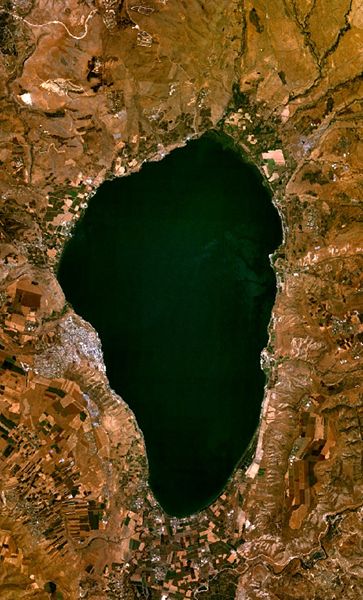Kinneret
The Lake Kinneret (Hebrew ים כנרת, also called Sea of Galilee, Sea of Genneseret, Lake Tiberias or Sea of Kinneret according to Numbers 34:11; Joshua 13:27) originates its name from the Hebrew word kinnor ("harp" or "lyre") in view of the shape of the lake.

The Lake Kinneret is Israel's largest freshwater lake, being approximately 53 km (33 miles) in circumference, about 21 km (13 miles) long, and 13 km (8 miles) wide. The lake has a total area of 166 km², and a maximum depth of approximately 43 meters. At 209 meters below sea level, it is the lowest freshwater lake on Earth and the second-lowest lake in the world after the Dead Sea, a salt water lake.
The Kinneret is situated deep in the Jordan Great Rift Valley, the valley caused by the separation of the African and Arabian Plates and is fed partly by underground springs although its main source is the Jordan River which flows through it from north to south. Consequently the area is subject to earthquakes and, in the past, volcanic activity. This is evidenced by the abundant basalt and other igneous rocks that define the geology of the Galilee region.
Due to its low-lying position in the rift valley, surrounded by hills, the sea is prone to sudden violent storms; hence the New Testament account of Jesus calming the storm. It is still noted, as in New Testament times, for its rich fish stocks.
The Kinneret lies on the ancient Via Maris which linked Egypt with the northern empires. The Greeks, Hasmoneans, and Romans founded flourishing towns and settlements on the lake including Gadara, Hippos and Tiberias. The first-century historian Flavius Josephus was so impressed by the area that he wrote, "One may call this place the ambition of Nature." Josephus also reported a thriving fishing industry at this time, with 230 boats regularly working in the lake.
Much of the ministry of Jesus occurred on the shores of Lake Galilee. In those days, there was a continuous ribbon development of settlements and villages around the lake and plenty of trade and ferrying by boat. The Synoptic gospels of Mark (1:14-20), Matthew (4:18-22), and Luke (5:1-11) describe how Jesus recruited four of his apostles from the shores of Lake Galilee: the fishermen Simon and his brother Andrew and the brothers John and James. One of Jesus' famous teaching episodes, the Sermon on the Mount, was given on a hill overlooking the lake while many of his miracles were also recorded to occur here including his walking on water, calming a storm, and his feeding five thousand people (in Tabgha).
In 135 CE the second Jewish revolt against the Romans was put down. The Romans responded by banning all Jews from Jerusalem. The centre of Jewish culture and learning shifted to the region of the Kinneret, particularly the city of Tiberias. It was in this region that the so-called "Jerusalem Talmud" is thought to have been compiled.